Posted by
Darrell Mordecai
As Google and other search engines progress, SEO is constantly evolving.
One of the biggest evolutions is semantic SEO.
Semantic SEO is a branch of SEO that seems to have flown under the radar for many. What’s interesting is that semantic search is here to stay as Google is doubling down on semantic search with many of its algorithms.
For instance:
- Hummingbird
- Rank Brain
- Bert
- Mum
This means understanding how Google structures entities in its Knowledge Graph and incorporating that knowledge into your site structure is becoming more important every day.
In this post, I’ll cover what a topical map is and how you can use it to structure your content so that your site content can be easily understood by both users and search engines.
But before I explain what you need to do, I first have to ask the obvious question.
Why?
Why Do You Need a Topical Map?
When trying to get more Google traffic, one of the best strategies is to achieve topical relevance. Topical relevance is a semantic SEO strategy that aims to position your site as the authority for one or more topics.
To be an authority for your topic in the eyes of Google, your site needs to cover the length and breadth of your chosen topic or entity.
What’s more, it must be structured in a parent-child hierarchy. This is important for two reasons.
It not only helps your users find the content they are looking for, but it also helps search engines understand what your site is about. And since semantic search is all about how search engines understand your content, the better they understand your content the more they will reward your site with higher visibility.
So the question is, how exactly do you do that?
It all starts with creating a plan. From experience, I’ve seen many SEO strategies that look something like this:
- Create lots of content
- Hope it ranks
- Rinse and repeat
The obvious problem with this approach is that it’s like building a house one brick at a time without having a plan. Not having a plan will inevitably lead to structural problems.
To solve this you must create a topical map.
How to Create a Topical Map
Your topical map is your blueprint. It should define all the content you need to create to achieve topical authority for a given topic.
To create this hierarchy you will need to understand how to break your primary topic into subcategories. Once you’ve done that you should create a content network for each sub-topic that covers every possible question a Google user might ask.
Your structural hierarchy is built and takes shape through building logical internal links that have relevant anchor texts as well as a logical URL structure that includes folders and sub-folders.
Now I understand that this all sounds like a mouthful, but have no fear, I’ll take you through the process step-by-step.
Topics and Sub-Topics
So, in order to create a well-structured content network, it pays to first figure out how Google structures your topic into a topic / sub-topic hierarchy. The reason this is so important is Google most likely already includes your primary entity in its Knowledge Graph. Google’s Knowledge Graph includes a topic layer which means each topic is structured in a topic/sub-topic structure.
And, since you are not only creating a structure that is designed to help your users, but you are also designing a structure that will help Google to understand what your site is about, it pays to align your structure with the way Google already ‘understands’ the topic.
The best place to figure this out is the Google SERPs. Start to create lists of related entities and related queries by looking at SERP features such as:
- Knowledge Panels
- People Also Ask boxes
- Auto-Suggest
I covered the topical authority research approach in my previous blog post. Although not essential to this post, reading that post will give you specific steps you can take to generate a solid list of related queries and related entities.
Let’s imagine you’ve done topical analysis and you’ve compiled a list of entities and queries. So what do you do now?
It’s time to create your hierarchy.
This means you need to figure out how Google breaks your topic into sub-topics. In my previous post (linked to above) I suggest looking at Knowledge Panels to find sub-topics. In that post, when researching the Finnish composer Jean Sibelius, we saw the Knowledge Panel had two sub-topics:
This means your main entity, Jean Sibelius is at the top and a level down should be compositions and tone poems.
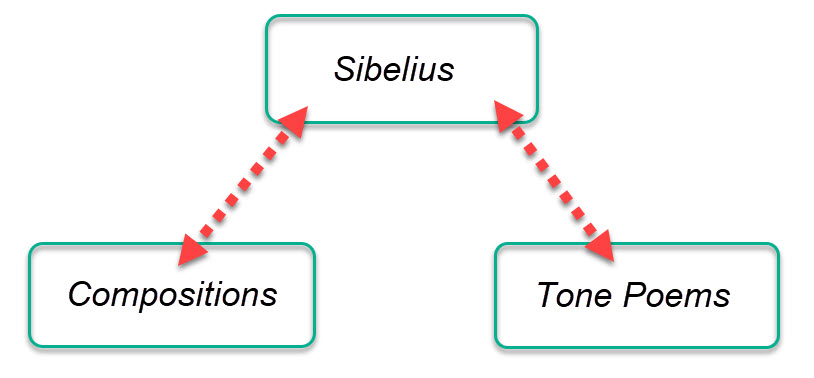
As I am writing this blog post I’ve noticed that the Knowledge Panel has changed. It now no longer lists Tone Poems as a sub-topic of compositions.
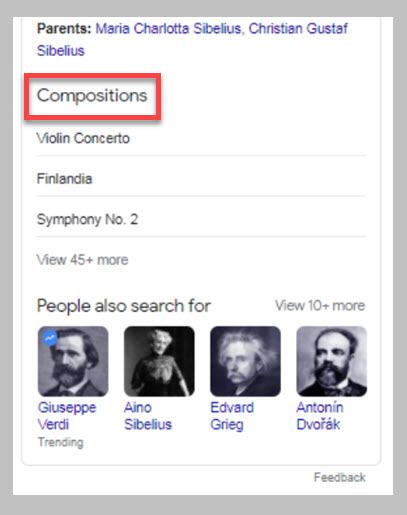
If you click the ‘View 45+ more’ link on the Compositions tab in the Knowledge Panel you’ll see this:

Google has redirected us to the Jean Sibelius compositions results page.
If you scroll down to the bottom of the Knowledge Panel on this results page you do see a Tone poems sub-topic.
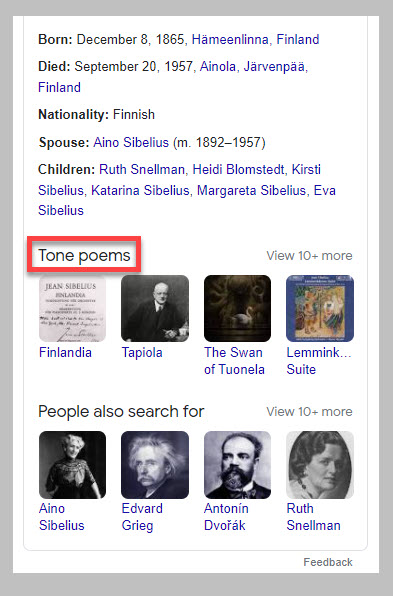
What does this all mean?
It seems to me that Google has re-arranged these sub-topics in the Knowledge Graph. ‘Tone poems’ is now a sub-topic of the sub-topic ‘compositions’.
This means it stands to reason that your hierarchy should look something like this:
The top-level should include the entity, Jean Sibelius. A level down should include compositions. This should be broken down into sub-topics symphonies and tone poems.
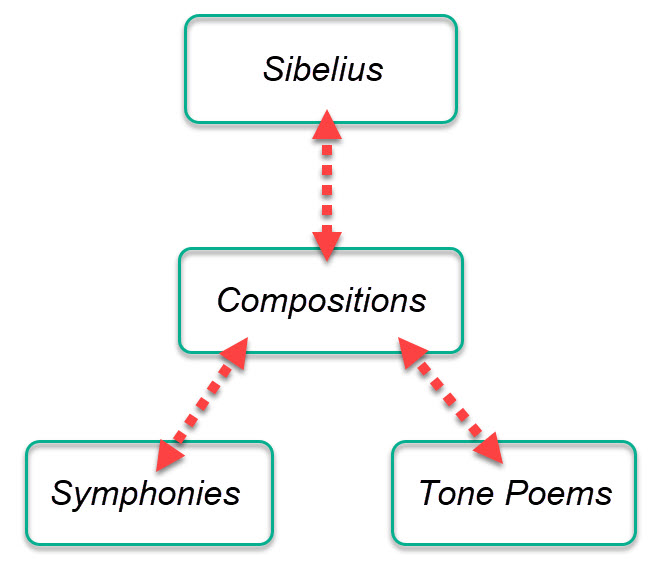
This is not the only way to figure out topic / sub-topic hierarchies. If you simply can’t find any good sub-topics on the Google SERPs you can see how Google connects topics by looking at Google Trends.
Google Trends Related Topics Report
Google Trends is a great place to find related topics. The Related Topics report will give you a list of topics that are related to your topic. According to Google ‘Users that search for your term also search for these topics’.
This means to Google, the topics are related to your topic.
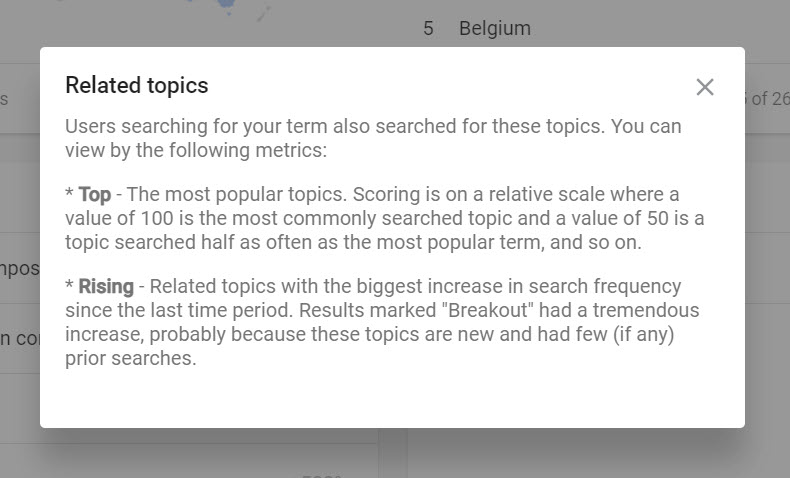
Although this is a great place to start, from personal experience you might have to dig around for something that’s actually relevant to your content. In other words, don’t add every related topic to your content hierarchy.
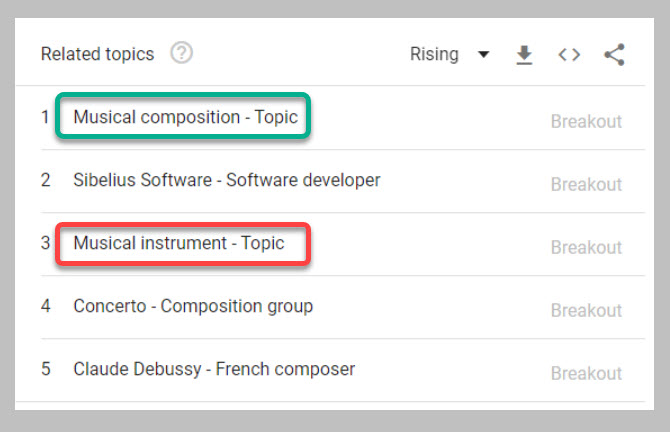
For instance, in the screenshot above, the topic ‘musical composition’ would make sense as a sub-topic (as we have already added it to our content map) but the topic ‘musical instrument’ would not make sense. Although it is relevant in some way to our topic, it’s far too generic to use as a sub-topic for the topic Jean Sibelius.
Another place to find second-level sub-topics is to look at related queries. (Warning, this approach does require thinking. 😛)
Sub-Topics Based on Query Analysis
In the previous steps, we discussed finding related topics in Knowledge Panels and Google Trends. I’ll now show you how to find related topics by looking at related queries.
Now as I mentioned above, creating a topical map requires research. When researching your topic, one of the things you are looking for is related queries. As I mentioned in my last blog post (linked to above), the best way to find related queries is to look at People Also Ask boxes.
Look at these queries. Are there any that can be obviously grouped into their own sub-topic?
For instance…
Both sub-topics we’ve included so far are related to Sibelius’s compositions. However, you might have more general information about Sibelius that doesn’t relate to his compositions. There might be some personal content that you want to include on your site.
Here are some non-music-related queries taken from the People Also Ask box:
- What was Jean Sibelius’s religion?
- Why did Jean Sibelius change his name?
- What languages did Jean Sibelius speak?
- Where is Sibelius buried?
Since these related queries represent what actual users are asking, it might be worth your time to create a separate sub-topic for all of this content. That means your hierarchy could look like this:
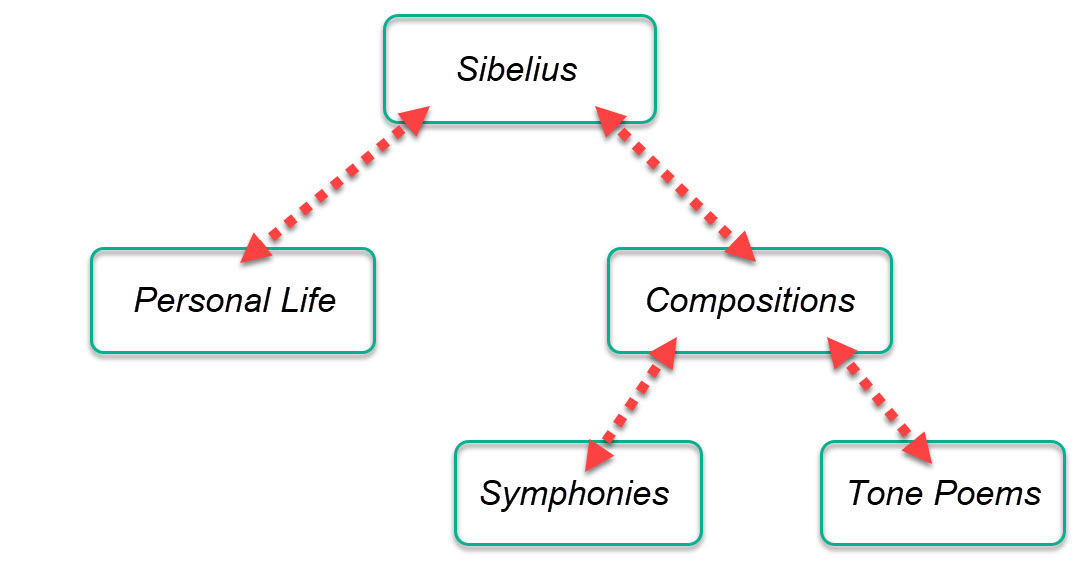
Now that you have your hierarchy figured out it’s time to figure out what content you need to create.
Plan Your Content
At this point, you should have a logical structure for your content. Each item in your hierarchy will include its own content. So, think of your categories and sub-categories as folders and sub-folders.
Now you need to figure out what goes into each folder. To do this, it’s time to look at the related queries in your research list. If you’ve done a good job setting up your hierarchy, each query should fit logically into the structure. If there are some queries that simply don’t fit, you might need to go back a step and add a category.
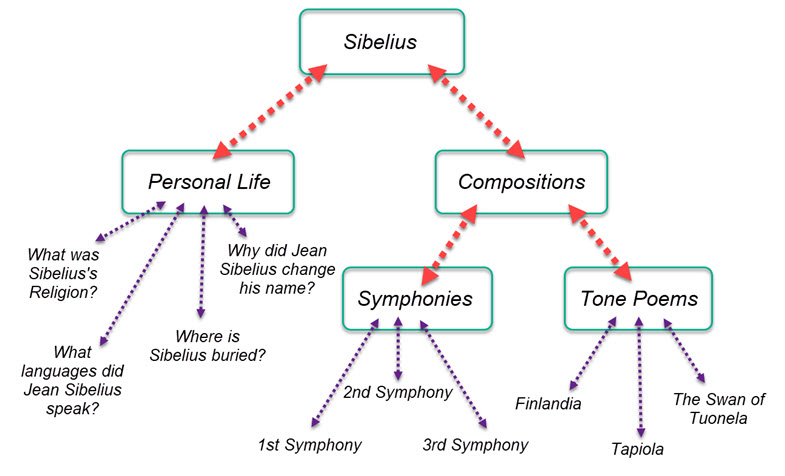
Now that you have your big picture figured out, it’s time to create your site architecture.
Translating Your Topical Map into Site Architecture
You now have a solid topical map including topics and sub-topics. You also have a solid list of queries about each topic and sub-topic.
The next step is to structure your website content around your topical map. There is more than one way to do this and you don’t have to do all of them.
Here are some options:
- Internal links
- Bread crumbs
- URL structure
- Schema markup
It’s important to understand that Google might not need all of these to understand your site’s content. However, the most important one is internal linking.
Having said that, adding bread crumbs or a clearly thought-out URL structure and site architecture are best practices that can really improve your user experience. Especially if you have a large amount of blog content.
This is all part of a bigger discussion that I will have to leave for another post.
Discover how Rank Ranger can enhance your business
All the data in insights you need to dominate the SERPs

